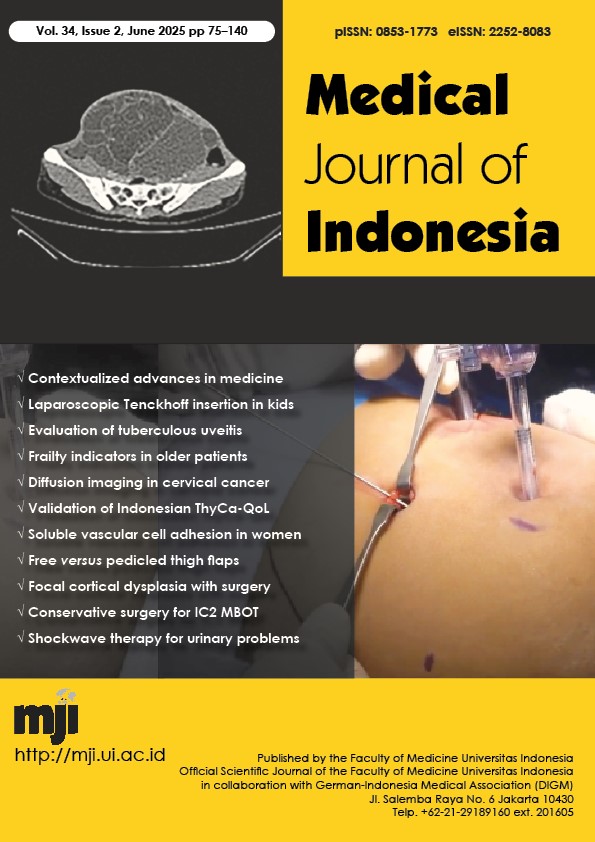Comparison between free and pedicled anterolateral thigh flaps and surgical outcomes in soft tissue reconstruction
DOI:
https://doi.org/10.13181/mji.oa.258140Keywords:
necrosis, reconstructive surgical procedures, soft tissue injuries, surgical flaps, thigh, wound dehiscenceAbstract
BACKGROUND The anterolateral thigh (ALT) flap, harvested either as a free flap with microsurgical anastomosis or as a pedicled flap with an intact blood supply, is widely used to repair soft tissue defects. This study aimed to evaluate the ALT flap, both free and pedicled variants, as a reliable option for reconstruction, focusing on flap viability and complications.
METHODS This cross-sectional study included 30 patients who underwent free or pedicled ALT flap reconstruction at IGNG Ngoerah Hospital, Bali, between 2020 and 2024. Inclusion criteria were complete medical records and confirmed vascular flow on preoperative Doppler ultrasound. Statistical analysis was performed using Fisher’s exact test for bivariate analysis. The primary outcomes evaluated were the incidence of complications and their association with the type of flap.
RESULTS ALT flaps were used as free flaps in 60% of cases and as pedicled flaps in 40%. Most patients were adult males, with flap placements mainly in the abdomen (36.7%). Wound dehiscence and necrosis occurred in 13.3% of cases. Wound dehiscence and complications requiring follow-up occurred more frequently in patients undergoing free flap procedures (38.9% versus 8.3%, p<0.001; 22.2% versus 0%, p = 0.001). In contrast, the incidence of necrosis was comparable between the two flaps (16.75% versus 8.3%, p = 0.632).
CONCLUSIONS The free ALT flap showed a higher risk of partial flap necrosis and required more intensive monitoring. Pedicled ALT flap demonstrated a lower complication rate and more straightforward postoperative care, suggesting a more favorable option.
Downloads
References
Mansour AM, Jacobs A, Raj MS, Lee FG, Terrasse W, Wallace SJ, Miller NF. Lower extremity soft tissue reconstruction review article. Orthop Clin North Am. 2022;53(3):287-96. https://doi.org/10.1016/j.ocl.2022.03.003
Nyffeler R, Morgenstern M, Osinga R, Kuehl R, Gahl B, Imhof A, et al. Fracture-related infections of the lower extremity - analysis of costs and their drivers. Injury. 2025;56(2):112138. https://doi.org/10.1016/j.injury.2024.112138
Wei FC, Jain V, Celik N, Chen HC, Chuang DC, Lin CH. Have we found an ideal soft-tissue flap? An experience with 672 anterolateral thigh flaps. Plast Reconstr Surg. 2002;109(7):2219-26. https://doi.org/10.1097/00006534-200206000-00007
Atmodiwirjo P, Ramadan MR, Triatmoko SE, Ralena NA. How to harvest the anterolateral thigh free flap. J Plast Rekons. 2024;7(1):1-3. https://doi.org/10.14228/jpr.v7i1.294
DI Summa PG, Watfa W, Campisi C, Giordano S, Oranges CM, Elahi-Rausis L, et al. Free versus pedicled anterolateral thigh flap for abdominal wall reconstruction. Anticancer Res. 2019;39(12):6759-68. https://doi.org/10.21873/anticanres.13891
Cornette de Saint-Cyr B, Garey LJ, Maillard GF, Aharoni C. The vertical midface lift. An improved procedure. J Plast Reconstr Aesthet Surg. 2007;60(12):1277-86. https://doi.org/10.1016/j.bjps.2007.05.002
Lee KJ, Park I, Roh SY, Koh SH, Kim JS, Lee DC, et al. Usefulness of color doppler ultrasonography for the preoperative evaluation of thin anterolateral thigh flap perforators. Arch Hand Microsurg. 2021;26(4):270-5. https://doi.org/10.12790/ahm.21.0105
Oleck NC, Gu C, Pyfer BJ, Phillips BT. Defining mastectomy skin flap necrosis: a systematic review of the literature and a call for standardization. Plast Reconstr Surg. 2022;149(5):858e-66e. https://doi.org/10.1097/PRS.0000000000008983
Rosen RD, Manna B. Wound Dehiscence. [Updated 2023 May 1]. In: StatPearls [Internet]. Treasure Island (FL): StatPearls Publishing; 2025.
Mishra JK, Sahu S, De M, Saha A. Pedicled anterolateral thigh flap: a versatile flap for complex regional defect reconstruction. GMS Interdiscip Plast Reconstr Surg DGPW. 2023;12:Doc04. https://doi.org/10.3205/iprs000174
Sharma M, Kumar N, Babu VS. Pedicled anterolateral thigh flap as a workhorse flap for reconstruction of inguino-scrotal defects. J Med Res Surg. 2021;2(S3):1-6. https://doi.org/10.52916/jmrs21S103
Knoedler S, Hoch CC, Huelsboemer L, Knoedler L, Stögner VA, Pomahac B, et al. Postoperative free flap monitoring in reconstructive surgery-man or machine? Front Surg. 2023;10:1130566. https://doi.org/10.3389/fsurg.2023.1130566
Kim DY, Lee TJ, Kim EK, Yun J, Eom JS. Intraoperative venous congestion in free transverse rectus abdominis musculocutaneous and deep inferior epigastric artery perforator flaps during breast reconstruction: a systematic review. Plast Surg (Oakv). 2015;23(4):255-9.
Lese I, Biedermann R, Constantinescu M, Grobbelaar AO, Olariu R. Predicting risk factors that lead to free flap failure and vascular compromise: a single unit experience with 565 free tissue transfers. J Plast Reconstr Aesthet Surg. 2021;74(3):512-22. https://doi.org/10.1016/j.bjps.2020.08.126
Mohanty RR, Mishra R, Nayak B, Nayak BB. Versatility of antero-lateral thigh free flap in reconstruction of defects in different parts of our body- our experience. Int J Health Sci. 2022;6(S7):1743-58. https://doi.org/10.53730/ijhs.v6nS7.11658
Atilgan N, Ipek B, Duman N, Orhan O, Yilmaz M. Can anterolateral thigh flap be a rescuer in lower extremity injuries? Eur Rev Med Pharmacol Sci. 2023;27(15):7005-11. https://doi.org/10.26355/eurrev_202308_33272
Published
How to Cite
Issue
Section
License
Copyright (c) 2025 Agus Roy Rusly Hariantana Hamid

This work is licensed under a Creative Commons Attribution-NonCommercial 4.0 International License.
Authors who publish with Medical Journal of Indonesia agree to the following terms:
- Authors retain copyright and grant Medical Journal of Indonesia right of first publication with the work simultaneously licensed under a Creative Commons Attribution-NonCommercial License that allows others to remix, adapt, build upon the work non-commercially with an acknowledgment of the work’s authorship and initial publication in Medical Journal of Indonesia.
- Authors are permitted to copy and redistribute the journal's published version of the work non-commercially (e.g., post it to an institutional repository or publish it in a book), with an acknowledgment of its initial publication in Medical Journal of Indonesia.






































